Nokia 2009 Annual Report Download - page 226
Download and view the complete annual report
Please find page 226 of the 2009 Nokia annual report below. You can navigate through the pages in the report by either clicking on the pages listed below, or by using the keyword search tool below to find specific information within the annual report.-
 1
1 -
 2
2 -
 3
3 -
 4
4 -
 5
5 -
 6
6 -
 7
7 -
 8
8 -
 9
9 -
 10
10 -
 11
11 -
 12
12 -
 13
13 -
 14
14 -
 15
15 -
 16
16 -
 17
17 -
 18
18 -
 19
19 -
 20
20 -
 21
21 -
 22
22 -
 23
23 -
 24
24 -
 25
25 -
 26
26 -
 27
27 -
 28
28 -
 29
29 -
 30
30 -
 31
31 -
 32
32 -
 33
33 -
 34
34 -
 35
35 -
 36
36 -
 37
37 -
 38
38 -
 39
39 -
 40
40 -
 41
41 -
 42
42 -
 43
43 -
 44
44 -
 45
45 -
 46
46 -
 47
47 -
 48
48 -
 49
49 -
 50
50 -
 51
51 -
 52
52 -
 53
53 -
 54
54 -
 55
55 -
 56
56 -
 57
57 -
 58
58 -
 59
59 -
 60
60 -
 61
61 -
 62
62 -
 63
63 -
 64
64 -
 65
65 -
 66
66 -
 67
67 -
 68
68 -
 69
69 -
 70
70 -
 71
71 -
 72
72 -
 73
73 -
 74
74 -
 75
75 -
 76
76 -
 77
77 -
 78
78 -
 79
79 -
 80
80 -
 81
81 -
 82
82 -
 83
83 -
 84
84 -
 85
85 -
 86
86 -
 87
87 -
 88
88 -
 89
89 -
 90
90 -
 91
91 -
 92
92 -
 93
93 -
 94
94 -
 95
95 -
 96
96 -
 97
97 -
 98
98 -
 99
99 -
 100
100 -
 101
101 -
 102
102 -
 103
103 -
 104
104 -
 105
105 -
 106
106 -
 107
107 -
 108
108 -
 109
109 -
 110
110 -
 111
111 -
 112
112 -
 113
113 -
 114
114 -
 115
115 -
 116
116 -
 117
117 -
 118
118 -
 119
119 -
 120
120 -
 121
121 -
 122
122 -
 123
123 -
 124
124 -
 125
125 -
 126
126 -
 127
127 -
 128
128 -
 129
129 -
 130
130 -
 131
131 -
 132
132 -
 133
133 -
 134
134 -
 135
135 -
 136
136 -
 137
137 -
 138
138 -
 139
139 -
 140
140 -
 141
141 -
 142
142 -
 143
143 -
 144
144 -
 145
145 -
 146
146 -
 147
147 -
 148
148 -
 149
149 -
 150
150 -
 151
151 -
 152
152 -
 153
153 -
 154
154 -
 155
155 -
 156
156 -
 157
157 -
 158
158 -
 159
159 -
 160
160 -
 161
161 -
 162
162 -
 163
163 -
 164
164 -
 165
165 -
 166
166 -
 167
167 -
 168
168 -
 169
169 -
 170
170 -
 171
171 -
 172
172 -
 173
173 -
 174
174 -
 175
175 -
 176
176 -
 177
177 -
 178
178 -
 179
179 -
 180
180 -
 181
181 -
 182
182 -
 183
183 -
 184
184 -
 185
185 -
 186
186 -
 187
187 -
 188
188 -
 189
189 -
 190
190 -
 191
191 -
 192
192 -
 193
193 -
 194
194 -
 195
195 -
 196
196 -
 197
197 -
 198
198 -
 199
199 -
 200
200 -
 201
201 -
 202
202 -
 203
203 -
 204
204 -
 205
205 -
 206
206 -
 207
207 -
 208
208 -
 209
209 -
 210
210 -
 211
211 -
 212
212 -
 213
213 -
 214
214 -
 215
215 -
 216
216 -
 217
217 -
 218
218 -
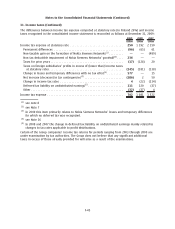 219
219 -
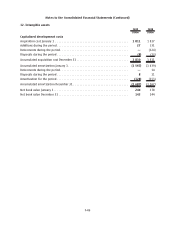 220
220 -
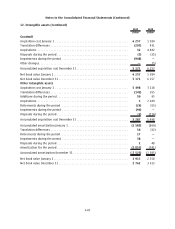 221
221 -
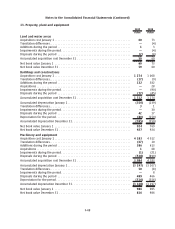 222
222 -
 223
223 -
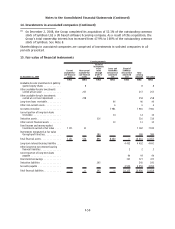 224
224 -
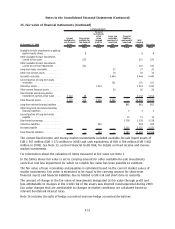 225
225 -
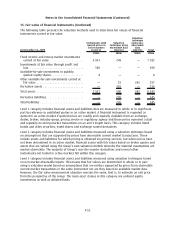 226
226 -
 227
227 -
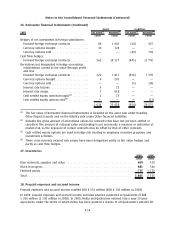 228
228 -
 229
229 -
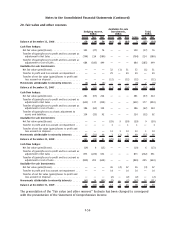 230
230 -
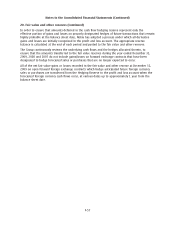 231
231 -
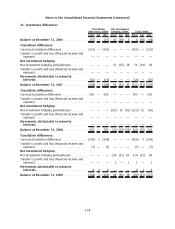 232
232 -
 233
233 -
 234
234 -
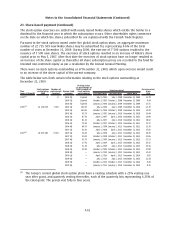 235
235 -
 236
236 -
 237
237 -
 238
238 -
 239
239 -
 240
240 -
 241
241 -
 242
242 -
 243
243 -
 244
244 -
 245
245 -
 246
246 -
 247
247 -
 248
248 -
 249
249 -
 250
250 -
 251
251 -
 252
252 -
 253
253 -
 254
254 -
 255
255 -
 256
256 -
 257
257 -
 258
258 -
 259
259 -
 260
260 -
 261
261 -
 262
262 -
 263
263 -
 264
264
 |
 |

15. Fair value of financial instruments (Continued)
The following table presents the valuation methods used to determine fair values of financial
instruments carried at fair value:
At December 31, 2009
Instruments with
quoted prices in
active markets
(Level 1)
Valuation
technique using
observable data
(Level 2)
Valuation
technique
using non
observable
data
(Level 3) Total
EURm EURm EURm EURm
Fixed income and moneymarket investments
carried at fair value . .................... 6933 249 — 7182
Investments at fair value through profit and
loss .................................. 580 — — 580
Availableforsale investments in publicly
quoted equity shares .................... 8 — — 8
Other availableforsale investments carried at
fair value ............................. — 15 242 257
Derivative assets ......................... — 316 — 316
Total assets ............................. 7521 580 242 8343
Derivative liabilities . . . .................... — 245 — 245
Total liabilities ........................... — 245 — 245
Level 1 category includes financial assets and liabilities that are measured in whole or in significant
part by reference to published quotes in an active market. A financial instrument is regarded as
quoted in an active market if quoted prices are readily and regularly available from an exchange,
dealer, broker, industry group, pricing service or regulatory agency and those prices represent actual
and regularly occurring market transactions on an arm’s length basis. This category includes listed
bonds and other securities, listed shares and exchange traded derivatives.
Level 2 category includes financial assets and liabilities measured using a valuation technique based
on assumptions that are supported by prices from observable current market transactions. These
include assets and liabilities for which pricing is obtained via pricing services, but where prices have
not been determined in an active market, financial assets with fair values based on broker quotes and
assets that are valued using the Group’s own valuation models whereby the material assumptions are
market observable. The majority of Group’s overthecounter derivatives and several other
instruments not traded in active markets fall within this category.
Level 3 category includes financial assets and liabilities measured using valuation techniques based
on non market observable inputs. This means that fair values are determined in whole or in part
using a valuation model based on assumptions that are neither supported by prices from observable
current market transactions in the same instrument nor are they based on available market data.
However, the fair value measurement objective remains the same, that is, to estimate an exit price
from the perspective of the Group. The main asset classes in this category are unlisted equity
investments as well as unlisted funds.
F52
Notes to the Consolidated Financial Statements (Continued)
